Former Microsoft Xbox Head Credits Apple Watch With Saving His Life
 Credit: The Street
Credit: The Street
Toggle Dark Mode
The former head of Microsoft’s Xbox division says his Apple Watch literally saved his life. Veteran tech executive Peter Moore credits the wearable’s low heart rate alerts with notifying him of a serious health issue that resulted in having a pacemaker implanted to restore a regular heartbeat.
Moore has worked several years in the technology sector for a number of well-known companies, serving as the head of Sega, Microsoft’s Xbox division, Electronic Arts’ sports division, and also as the CEO of Liverpool’s soccer team. Moore is currently employed as Senior Vice President and General Manager of Unity Technologies’ Sports and Live Entertainment division.
Moore said he was recently driving to the airport to pick up his daughter when he felt “a little lightheaded and a little faint,” he told KTLA reporter Rich DeMuro. “Like a typical male, I thought, ‘I’ll go to Starbucks. That’ll fix it.'”
When his Apple Watch began to alert him with several “low heart rate” warnings, he manually performed an ECG using the Apple Watch. It showed that his heart rate had precipitously fallen to 32 beats per minute. (A “normal” resting heart rate is usually between 50 and 60 BPM.)
Moore immediately pulled his car over and called his wife, who told him to stay put. She came to where he was parked, picked him up, and took Moore to a nearby hospital.
Moore says that soon after he arrived, “the doctor kind of theatrically ran in and said, This is not good. This is not good. You need a pacemaker right now.'” Moore immediately underwent surgery to have a pacemaker installed, and he now says that he “feels great.”
“Yes, his watch had a big role in saving his life,” said Omid Yousefian, the electrophysiologist at Sansum Clinic Cardiology who treated Moore.
“These days, 25% of the population over the age of 40 … have a high chance of experiencing atrial fibrillation,” Yousefian explained.
Yousefian said Moore responded properly to his Apple Watch’s notifications. He says Moore “was notified by his watch that his heart rate is slow and he correlated that with the symptoms that he had. He didn’t wait. He didn’t sit. He came to the hospital directly. So he made a very smart move.”
Moore praised his Apple Watch for saving his life. “I wouldn’t be here if it wasn’t for this little device,” Moore said. He then credited the Apple Watch for “literally informing you about your health in real-time. And in my instance, I think, saving my life.”
The Apple Watch has had the ability to alert users when their heart rate is too low or too high since the debut of the original Apple Watch — and it’s been saving lives since the very start. The feature is supported for users 13 and older.
High and low heart rate notifications
It’s easy to enable notifications from the Heart Rate app on your Apple Watch. If your heart rate remains above or below your selected beats per minute (BPM), your Apple Watch will notify you. It’s easy to confirm that the feature is enabled on your Apple Watch.
You can turn on heart rate notifications the first time you open the Heart Rate app on your Apple Watch or at any time via your iPhone:
- On your iPhone, open the Watch app.
- Tap the My Watch tab.
- Tap Heart.
- Tap High Heart Rate and choose a BPM. You can select a high heart rate between 100 and 150 BPM in 10 BPM increments.
- Tap Low Heart Rate and choose a BPM. You can select a low heart rate between 40 and 50 BPM in 5 BPM increments.







